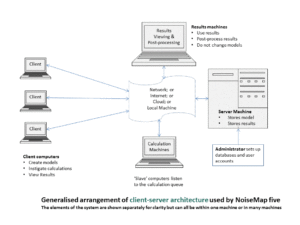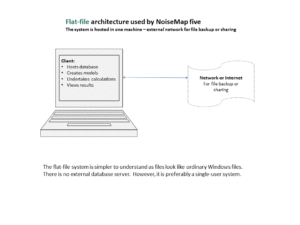NoiseMap five
NoiseMap five can model and predict most types of open-air noise, including:
- Road Traffic Noise
- Railway Noise
- Industrial Noise
- Construction Noise
- Wind Farms
- Mineral Extraction
- Waste Disposal/Landfill
- Festivals
It has the tools that professional users expect and need for projects both large and small. These are designed to allow:
- Team co-operation
- Version control
- Quality assurance
- Design tools
- Scripting of complex operations
- Results management and processing.
This is achieved through advanced database technology built right into NoiseMap five to store the noise model and all the calculation results. It allows models of practically unlimited size and complexity to be created and handled efficiently. The architecture of the system is shown below.
 We offer our own ‘cloud’ server which lets you work on the same model with many users in different places, or you can set up your own system by means of software that we supply.
We offer our own ‘cloud’ server which lets you work on the same model with many users in different places, or you can set up your own system by means of software that we supply.
You do not have to use an external server. NoiseMap’s built-in technology can operate from a local flat-file database, which appears as an ordinary Windows file. The user interface is practically identical once you are connected, although some options, such as multi-user access and distributed computing are not available.
 With the ‘server’ database, users can be located anywhere: all that is needed is a network or internet connection to the server. The databases are protected by user names and passwords and are also encrypted. The database server should be located behind a secure firewall. All users share a single database, so they can see and use each other’s work, but the system prevents conflicts arising when two people try to modify the same objects.
With the ‘server’ database, users can be located anywhere: all that is needed is a network or internet connection to the server. The databases are protected by user names and passwords and are also encrypted. The database server should be located behind a secure firewall. All users share a single database, so they can see and use each other’s work, but the system prevents conflicts arising when two people try to modify the same objects.
The server is not used for doing the calculations – thisis because the NoiseMap system uses the UK calculation methods ‘natively’, i.e. as designed. Since they were originally intended for manual implementation, they were designed to be extremely computationally efficient, and NoiseMap makes the most of this.
NoiseMap five has many tools to automate noise modelling which means that you can quickly and easily create much larger and more elaborate noise models than in the past, whilst efficient calculation algorithms will use multi-core parallel and distributed processing to allow results to be produced in reasonable time-scales.
Calculation results can be shown in many ways – noise contours, levels at individual receivers, in plan, cross-section and 3-D. Results can be exported to CAD, GIS, Spreadsheets, word-processors and to high-quality scale drawings.
The scripting interface allows for automation of many of the model creation and production tasks.
For details of the server requirements, follow this link
